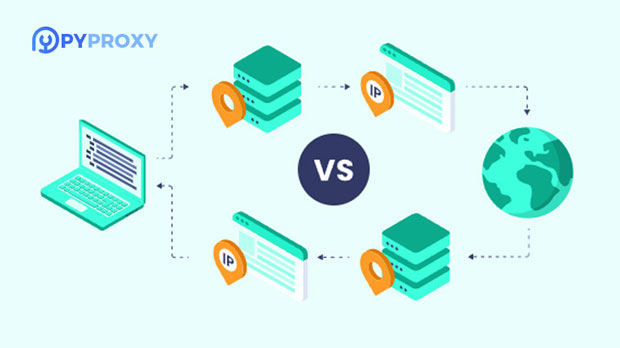When considering privacy and security online, many users wonder whether a free socks5 proxy or a VPN is the better choice. Both have their advantages and limitations, especially in terms of speed, security, and ease of use. The decision largely depends on the specific needs of the user, such as anonymity, unblocking content, or enhancing internet speed. This article will compare free socks5 proxies and VPNs available in the United States, delving into their core features, advantages, disadvantages, and ideal use cases to help you make an informed decision based on your needs. Understanding SOCKS5 Proxy and VPNBefore diving into a detailed comparison, it's important to understand the fundamental differences between a SOCKS5 proxy and a VPN.1. SOCKS5 Proxy: SOCKS5 is a protocol that routes internet traffic through a proxy server. It operates at a lower level compared to a VPN, handling any type of internet traffic—whether it’s for web browsing, gaming, or torrenting. Unlike traditional proxies, SOCKS5 doesn't alter the data you send or receive, offering better flexibility and speed for certain applications. However, it doesn’t encrypt your traffic, which can be a major downside when it comes to privacy.2. VPN (Virtual Private Network): A VPN creates a secure, encrypted tunnel between your device and the internet. It routes your internet traffic through a server located in another country or region, masking your IP address and encrypting your data in the process. This makes VPNs more secure than proxies, providing privacy and protection from hackers, government surveillance, and cyber threats. VPNs are widely used to access geo-restricted content and ensure secure browsing, but they can impact internet speed due to the encryption process.Key Differences between SOCKS5 Proxy and VPNWhile both services help protect user identity and allow access to geo-blocked content, they operate in fundamentally different ways. Below is a comparison of their core attributes:1. Security and EncryptionOne of the most significant differences between SOCKS5 proxies and VPNs is the level of security they offer.- SOCKS5 Proxy: SOCKS5 does not provide encryption, which means that while it can mask your IP address and route your traffic through a different server, your data is still exposed to potential threats. This lack of encryption makes it unsuitable for users who prioritize security or are engaging in sensitive activities such as online banking or sharing personal data. - VPN: A VPN, on the other hand, encrypts all the data passing through it. This means that not only is your IP address masked, but all of your internet activities are protected with a high level of encryption, making it much safer for privacy-sensitive tasks like secure browsing, accessing private accounts, and even using public Wi-Fi networks.2. Speed and PerformanceIn terms of speed, SOCKS5 proxies are often seen as the winner.- SOCKS5 Proxy: Because SOCKS5 doesn’t encrypt your data, it generally offers faster speeds than a VPN. For activities such as streaming, gaming, or torrenting where speed is important and security is less of a concern, SOCKS5 can be a good option. It also doesn’t introduce the additional overhead that encryption does, which makes it a more lightweight solution for these uses.- VPN: VPNs, while providing a higher level of security, often come with a performance trade-off. The encryption process requires additional resources, which can slow down your internet speed. This is especially noticeable when connecting to servers that are located far away from your physical location. However, some high-quality VPN services offer optimized servers that can mitigate speed loss, though it's still an inherent issue.3. Privacy and AnonymityWhen it comes to privacy, VPNs take the lead.- SOCKS5 Proxy: While SOCKS5 can mask your IP address, it does not provide the same level of privacy as a VPN. It doesn’t offer encryption, meaning your traffic can potentially be intercepted, especially by malicious third parties, including hackers and ISPs. Additionally, SOCKS5 proxies don’t hide the fact that you're using a proxy, which means websites and services can still detect proxy usage.- VPN: A VPN offers a far superior level of privacy. Not only does it mask your IP address, but it also encrypts your entire internet traffic, making it nearly impossible for anyone—be it hackers, ISPs, or government agencies—to track or monitor your online activities. Furthermore, most reputable VPN providers have a strict no-logs policy, meaning they don’t store any information about your browsing habits.4. Compatibility and Use CasesBoth services cater to different types of users based on their specific needs.- SOCKS5 Proxy: SOCKS5 is particularly useful for users who need to access specific applications like P2P file sharing (e.g., torrenting), bypassing regional restrictions for streaming, or even online gaming. It is preferred in situations where speed is more critical than security. SOCKS5 proxies are also commonly used for users who want to change their IP address to appear from a different region.- VPN: A VPN is best suited for users who need a comprehensive privacy solution. It is ideal for secure browsing, using public Wi-Fi without fear of being hacked, and accessing content that’s blocked in certain countries or regions. VPNs are also widely used by those who want to maintain anonymity online, such as journalists, activists, and individuals in regions with oppressive governments.5. Cost and AvailabilityCost is another key factor that can affect the decision between a SOCKS5 proxy and a VPN.- SOCKS5 Proxy: Free SOCKS5 proxies are widely available, though they often come with limitations such as reduced server locations, speed caps, and a lack of customer support. Free proxies may also be more likely to collect and log your data, which compromises privacy.- VPN: Free VPNs are available, but they usually come with restrictions, including limited bandwidth, slower speeds, and fewer server options. Additionally, free VPN providers may log your data or inject ads into your browsing experience. Premium VPN services offer more reliable and secure options but come with a subscription cost.Conclusion: Which is Better – free socks5 proxy or VPN?The choice between a free SOCKS5 proxy and a VPN depends on your priorities.- If speed and minimal setup are your primary concerns, and you don’t mind sacrificing security, a SOCKS5 proxy might be the right choice for you. It is well-suited for activities like streaming and torrenting, where encryption is less of a concern.- If security, privacy, and comprehensive protection are more important to you, then a VPN is the better option. A VPN provides end-to-end encryption, ensuring that your data remains private and secure, and is ideal for tasks that require anonymity or sensitive activities.Ultimately, the decision comes down to what you value more: speed or security. If you prioritize privacy and online security, a VPN is the clear winner. However, for less privacy-sensitive activities where speed is critical, a free SOCKS5 proxy might be sufficient.
Dec 27, 2024
![arrow]()



















































